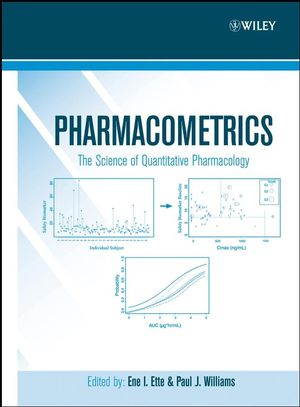Pharmacometrics: The Science of Quantitative PharmacologyISBN: 978-0-471-67783-3
Hardcover
1216 pages
April 2007
 This is a Print-on-Demand title. It will be printed specifically to fill your order. Please allow an additional 15-20 days delivery time. The book is not returnable.
|
||||||
Preface.
Acknowledgements.
Introduction.
Chapter 1. Pharmacometrics: Impacting Drug Development and Pharmacotherpay.
I: GENERAL PRINCIPLES.
Chapter 2. General Principles of Programming (Computer and Statistical).
Chapter 3. Validation of Software for Pharmacometric Analyses.
Chapter 4. Linear, Generalized Linear, and Nonlinear Mixed-Effects Models.
Chapter 5. Bayesian Hierarchical Modeling with Markov Chain Monte Carlo Methods.
Chapter 6. Estimating the Dynamics of Drug Regimen Compliance.
Chapter 7. Graphical Display for Modeling Population Data.
Chapter 8. The Epistemology of Pharmacometrics.
Chapter 9. Data Imputation.
II: POPULATION PHARMACOKINETIC BASIS OF PHARMACOMETRICS.
Chapter 10. Population Pharmacokinetic Estimation Methods.
Chapter 11. Timing and Efficiency in Population Pharmacokinetic / Pharmacodynamic Data Analysis.
Chapter 12. Designing Population Pharmacokinetic Studies for Efficient Parameter Estimation.
Chapter 13. Population Models for Drug Absorption and Entero-hepatic Recycling.
Chapter 14. Pharmacometric Knowledge Discovery from Clinical trial Data Sets.
Chapter 15. Resampling Techniques and Their Application to Pharmacometrics.
Chapter 16. The Population Approach to Bioequivalence.
III: PHARMACOKINETICS / PHARMACODYNAMICS RELATIONSHIP BIOMARKERS AND PHARMACOGENOMICS.
Chapter 17. Biomarkers in Drug Development and Pharmacometric Modeling.
Chapter 18. Analysis of Gene Expression Data.
Chapter 19. Pharmacogenomics and Pharmacokinetic/Pharmacodynamic Modeling.
Chapter 20. Empirical Pharmacokinetic/Pharmacodynamic Models.
Chapter 21. Developing Models of Disease Progression.
Chapter 22. Mechanistic Pharmacokinetic/Pharmacodynamic (PK/PD) Models.
Chapter 23. Mechanistic Pharmacokinetic/Pharmacodynamic Models II.
Chapter 24. PK/PD Analysis of Binary (Logistic) Outcome Data.
Chapter 25. Population Pharmacokinetic / Pharmacodynamic Modeling of Ordered Categorical Longitudinal Data.
Chapter 26. Transition Models in Pharmacodynamics.
Chapter 27. Mixed Effects Modeling of Count Data.
Chapter 28. Mixture Modeling with NONMEM.
IV. CLINICAL TRIAL DESIGNS.
Chapter 29. Designs for First Time-in-Man Studies in Non-Oncology Indications.
Chapter 30. Design for Phase I Studies in Oncology.
Chapter 31. Design and Analysis of Clinical Exposure - Response Trials.
V. PHARMACOMETRIC KNOWLEDGE CREATION.
Chapter 32. Pharmacometric Knowledge Creation: Towards Characterizing an Unexplored Region of the Response Surface.
Chapter 33. Clinical Trial Simulation: Theory.
Chapter 34. Modeling and Simulation: Planning and Execution.
Chapter 35. Clinical Trial Simulation: Efficacy Trials.
VI: PHARMACOMETRIC SERVICE AND COMMUNICATION.
Chapter 36. Engineering a Pharmacometrics Enterprise.
Chapter 37. Communication of Pharmacometric Analysis Outcome.
VII: SPECIFIC APPLICATIONS EXAMPLES.
Chapter 38. Pharmacometrics Applications in Population Exposure-Response Data for New Drug Development and Evaluation.
Chapter 39. Pharmacometrics in Pharmacotherapy and Drug Development: Pediatric Application.
Chapter 40. Pharmacometric Methods for Assessing Drug-Induced QT and QTc Prolongations for Non-Antiarrhythmic Drugs.
Chapter 41. Using Pharmacometrics in the Development of Biologic Therapeutic Agents.
Chapter 42. Analysis of Quantic Pharmacokinetic Study: Robust Estimation of Tissue-to-Plasma Ratio.
Chapter 43. Physiologically Based Pharmacokinetic Modeling: Inhalation, Ingestion and Dermal Absorption.
Chapter 44. Modeling of Metablite Pharmacokinetics in a Large Pharmacokinetic Data Set: An Application.
Chapter 45. Characterizing Nonlinear Pharmacokinetics: An Example Scenario for a Therapeutic Protein.
Chapter 46. Development, Evaluation and Applications of In Vitro/ In Vivo Correlations: A Regulatory Perspective.
Chapter 47. The Confluence of Pharmacometric Knowledge Discovery and Creation in the Characterization of Drug Safety.



